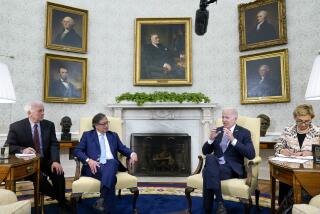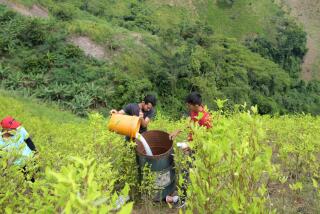Latin Gains Displayed During Albright Tour
PANAMA CITY — Secretary of State Madeleine Albright arrived here Saturday in a bid to patch up feelings that were hurt when neither she nor President Clinton attended the recent ceremony in which control of the Panama Canal was turned over to Panamanians.
Albright went on a brief tour of the Miraflores Locks section of the canal and recalled how, in the 1970s, she and other members of the Carter administration were proud of the decision to turn the waterway over to Panama.
“It was a source of great pride at that time, and I think it should be a source of great pride at this time,” she said.
“The United States,” she added, “should be justly proud of having built this amazing engineering feat.”
Albright was on the second day of a three-day trip to Latin America, where she is promoting anti-drug cooperation between the United States and its neighbors.
The visit comes just days after the Clinton administration proposed a huge expansion of U.S. aid to Colombia. A total of $1.6 billion would be used to purchase helicopters, set up anti-drug battalions, promote human rights efforts and foster economic development.
Earlier Saturday, in Colombia, Albright said that an extraordinary match in views between the United States and that country has opened the way for the South American nation to finally prevail in its battle against illegal drugs.
“This is one of those very important moments in national relations” when two countries’ plans are in complete harmony, she said at a joint news conference with Colombian President Andres Pastrana in the Caribbean port city of Cartagena. “This is when things work.”
For his part, Pastrana said that he was “heartened” by news of the recent White House proposal but that more help is needed from other nations.
“ ‘Plan Colombia’ is not an American plan. We are looking for the help of the United States, Europe, Asia and the entire world,” he said in reference to his government’s anti-drug strategy.
Pastrana expressed hope that the European Union will agree to help finance Colombia’s efforts to battle narcotics traffickers, perhaps at a conference of donors in Europe later this year.
In contrast to previous efforts, the U.S. aid plan for Colombia emphasizes a broad range of efforts, from military to economic. In addition, it would promote unprecedented cooperation between Colombia’s military and the police, who traditionally have taken the lead in the nation’s anti-drug programs.
Also Saturday, Albright toured Cartagena’s bustling container port, where she shook hands with a narcotics-sniffing German shepherd and emphasized U.S. support for Colombia’s widening effort to fight the drug trade.
“I pledge to you that the United States will continue to back this program and others like it,” she told a group of military and police officials standing at a site where 11 tons of cocaine and narcotics ingredients have been seized since 1998.
Top police and military officials, including Jose Serrano--Colombia’s chief drug fighter and head of the national police--accompanied Albright on the tour of the port facilities.
In what amounted to an unusual exercise of “show and tell,” they proudly displayed evidence of successful drug seizures.
A giant transport container was filled with cylindrical spools that had concealed cocaine. Nearby, a cargo container from Europe featured a mountain of white, plastic-filled sacks that had concealed a cache of precursor materials used in cocaine production.
After a meeting in Panama with President Mireya Moscoso, Albright planned to fly to Oaxaca, Mexico, before returning to Washington tonight.
More to Read
Sign up for Essential California
The most important California stories and recommendations in your inbox every morning.
You may occasionally receive promotional content from the Los Angeles Times.










